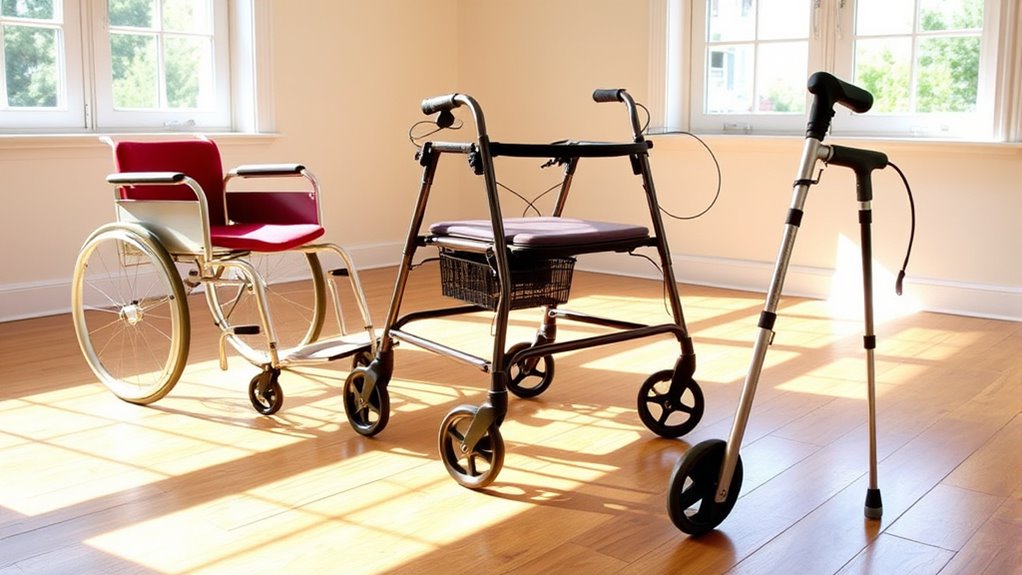To choose the right mobility aid, first assess your balance, strength, and daily needs. Consider where you’ll use it—indoor, outdoor, or both—and pick a device like a cane, walker, or scooter that matches your mobility level. Make sure it fits comfortably and suits your environment for safety. Budget and maintenance are also key. Keep exploring options and expert advice to find the best device for you—it’s easier than you think with the right guidance.
Key Takeaways
- Assess your mobility level, environment, and medical needs to determine suitable walking aids or powered devices.
- Consult healthcare professionals for personalized recommendations and proper device fitting.
- Consider device features like weight, terrain compatibility, and ease of use based on your daily routine.
- Factor in budget constraints, insurance coverage, and available support programs when choosing equipment.
- Prioritize safety, comfort, and adjustability to ensure the device effectively enhances mobility and reduces fall risk.
Understanding Different Types of Mobility Aids

Understanding the different types of mobility aids helps you choose the right support for your needs. Walking aids include various options like canes, which come in single-point and quad styles, offering lightweight support for mild balance issues. Professional equipment is essential for ensuring that mobility aids function effectively and safely.
Choosing the right mobility aid ensures safe and comfortable support tailored to your needs.
Walkers provide more stability with four-point contact and are adjustable to the correct height, helping you navigate safely if you have more significant mobility challenges. Rollators, a type of walker with wheels, often feature seats, brakes, and storage, making mobility easier for those who can walk but need extra support.
Crutches transfer weight from your legs to your upper body, ideal during injury recovery. For extensive support, power wheelchairs and mobility scooters offer motorized assistance, with different types of wheelchairs and scooter configurations tailored to your environment and mobility needs. Additionally, understanding the importance of user-friendly controls in mobility aids can enhance usability and comfort.
Assessing Your Personal Mobility Needs

Before choosing a mobility aid, it’s important to assess your personal needs to guarantee you select the right device. Start by evaluating your current mobility level—do you need help with stability, support, or covering long distances? Consult healthcare professionals or occupational therapists to get personalized advice based on your physical capabilities. Consider your environment—indoor, outdoor, or both—so your device suits terrain and space. Identifying any medical conditions, like arthritis or neurological issues, that impact your mobility is crucial, as safety gear can enhance your overall stability. Additionally, exploring options like suspension upgrades can improve your experience on uneven surfaces. It’s also beneficial to be aware of tax implications when investing in mobility aids that may qualify for tax deductions. Finally, think about how often and where you’ll use the aid to determine the most practical option. Additionally, understanding color accuracy can help ensure that any visual aids you might use are effective in different lighting conditions. The integration of AI technology in mobility aids is emerging, potentially enhancing user experiences through personalized adjustments and support.
Factors to Consider When Selecting Equipment

When choosing mobility equipment, you need to consider your mobility level to find the right support.
Think about where you’ll use the device most often, whether indoors, outdoors, or during travel. Electric bikes, for instance, can offer affordable options that enhance mobility and independence. Some users find that animated movies can provide a comforting distraction during their travels. Additionally, selecting equipment that promotes critical thinking and problem-solving can enhance your overall experience and adapt to your needs. For instance, using a lightweight design in your mobility aid can significantly improve your maneuverability in tight spaces.
Also, keep your budget in mind to ensure your selection is affordable and meets your safety and comfort needs. Additionally, consider the level of moisture your plants require, similar to how self-watering planters maintain ideal moisture levels for various plant types.
Mobility Level Requirements
How do you determine the right mobility aid for your needs? First, assess your mobility level by examining your ability to walk, maintain balance, and bear weight. If you have severe impairments, a motorized wheelchair or scooter might be necessary. Mild balance issues could be managed with a cane or rollator. Trust issues in navigating the selection process can also arise if you feel uncertain about your choices. Additionally, exploring DC Superheroes Supergirl Teen Costumes can provide inspiration for themed events that celebrate mobility independence.
Consider your walking aid needs based on how often and where you’ll use the device, whether indoors or outdoors. Understanding your emotional intelligence can also help you make informed decisions about your mobility aid, as it allows you to better assess your own needs and limitations. Additionally, incorporating color theory into your choices can enhance the visual aspect of the mobility aid, making it feel more personalized.
Your physical strength, endurance, and coordination also influence your choice; lightweight aids suit those with limited strength, while sturdier devices support greater support needs. Consulting healthcare professionals or occupational therapists can help ensure your selected equipment aligns with your current capabilities, promoting safe and comfortable movement tailored to your environment. Additionally, understanding filial responsibility laws can help you plan for potential financial burdens related to mobility aids.
Environment Compatibility Needs
Choosing the right mobility aid depends heavily on the environment where you’ll use it. If you often encounter rough terrain or uneven outdoor surfaces, opt for a device with larger wheels or all-terrain features to improve terrain compatibility. These enhancements provide better ground clearance and stability when steering through outdoor obstacles like curbs, gravel, or uneven pavement. Additionally, utilizing vertical storage solutions can help organize mobility aids effectively in your home environment. Many top beach towns also cater to individuals with mobility needs, ensuring accessibility to beautiful shorelines.
For indoor environments with limited space, consider compact, foldable models that are easier to maneuver and transport. Always match your device’s weight capacity and durability to your environment’s demands to guarantee safety and longevity. Assess whether your outdoor surfaces require more stability and terrain-specific features, so your mobility aid can handle outdoor obstacles confidently and comfortably. Additionally, incorporating high omega-3 fatty acids in your diet can support overall health and mobility.
Budget and Cost Limits
Budget and cost limits are key factors to contemplate because they directly influence which mobility aids are affordable for you. Your budget determines whether you choose manual or powered devices, since manual wheelchairs are generally less expensive and require less maintenance. Additionally, opting for affordable options like basic manual models can significantly reduce overall expenses while still providing essential mobility support.
Keep in mind the initial cost of the equipment and ongoing expenses like accessories, repairs, and maintenance. Regular use of mobility aids can help improve your overall mobility and reduce the risk of further health complications. Insurance coverage, such as Medicare, can help offset some costs, making higher-priced options more accessible. Understanding credit card terms can also play a crucial role in managing the finances associated with purchasing mobility aids. Furthermore, it is important to consider manufacturer guidelines for maintenance schedules to ensure the longevity and reliability of your mobility equipment.
To stay within your budget, consider purchasing from reputable suppliers or programs like Motability that offer financial assistance. Be mindful of the total cost, including accessories and upkeep, to ensure your mobility aid remains affordable and reliable in the long run. Additionally, understanding how coastal tourism can impact your local economy may help you evaluate potential funding for mobility aids in your area.
Exploring Purchasing Options and Support Resources

Are you aware of the diverse options available for purchasing mobility aids? You can explore various purchasing options, including medical supply stores like Southern Pharmaceutical Corporation, which offers a wide selection of brands such as Pride Mobility and Permobil.
Many vendors now provide both in-store and online shopping, giving you the flexibility to compare models, features, and prices easily.
Many vendors offer both in-store and online shopping options for easy comparison.
Support resources are available through mobility experts who can recommend personalized devices, assist with fitting, and answer questions about usage and maintenance.
Additionally, insurance coverage—such as Medicare—may help offset costs, and billing specialists can guide you through claims.
You might also find extra assistance from charities, grants, or government programs like the Motability scheme, making quality mobility aids more accessible.
Ensuring Proper Fit and Usage for Safety and Comfort

Ensuring your mobility aids fit properly and are used correctly is essential for safety and comfort. Proper fit helps prevent strain, improves stability, and reduces fall risk.
To achieve this, you should:
- Adjust the height of canes or walkers so your wrist or elbow bends 15-20 degrees.
- Ensure the aid’s placement, like crutches 2 inches below the armpit, avoids nerve compression.
- Check that rubber tips and brakes are in good condition through regular maintenance.
- Confirm the device fits your body measurements and environment for ideal comfort.
Correct placement and adjustment support safety, stability, and comfort during use.
Taking the time to maintain your mobility aids ensures they perform properly, reducing discomfort and preventing accidents.
Tips for Maintaining and Upgrading Your Mobility Devices

Regularly maintaining your mobility devices keeps them safe and reliable. Perform routine inspections for signs of wear and tear, like loose wheels, frayed straps, or corrosion, and address issues promptly.
Keep your device clean with mild soap and water, following manufacturer instructions, to prevent dirt buildup that can impair performance.
Replace worn-out parts such as handbrakes, tires, or cushions to guarantee safety and peak function.
Upgrading your device—like switching to lightweight frames or advanced controls—can improve comfort and ease of use as your needs change.
Schedule routine professional assessments to verify your device’s condition, receive maintenance recommendations, and explore upgrade options.
Proper maintenance and upgrades help prolong your device’s lifespan and keep performance at its best.
Frequently Asked Questions
What Factors Determine the Type of Mobility Aid Chosen for a Patient?
When choosing a mobility aid, you consider your level of mobility and strength, indoor or outdoor needs, and balance issues.
Your medical conditions, like injuries or neurological issues, also influence the choice.
Additionally, your size, weight capacity, and comfort preferences matter.
Which Type of Mobility Aid Would Be Most Appropriate?
When choosing the right mobility aid, you need to take into account your specific needs and mobility level.
If you have mild balance issues, a cane might be enough.
For more stability, a walker or rollator could be better.
If you’re recovering from an injury, crutches work well.
For extensive mobility or outdoor use, motorized wheelchairs or scooters are ideal.
Assess your situation carefully to find the most suitable support.
What Are the Different Types of Mobility Aids?
Imagine your journey as a path, and the right mobility aid as your trusted companion guiding you. You have canes that gently support your steps, walkers providing a sturdy hand, and rollators offering comfort with added features.
Crutches shift your weight like a bridge, while power wheelchairs and scooters become your wings, lifting you effortlessly across terrains. Each aid is crafted to help you move confidently and reclaim your independence.
What Is the Best Walking Aid for Poor Balance?
When considering the best walking aid for poor balance, you should prioritize stability and support. A walker with four points of contact and hand brakes offers the most security, helping you feel confident and safe.
Rollators with sturdy frames and a seated option can also boost your confidence.
Conclusion
Choosing the right mobility aid is like finding a trusted partner that supports you every step of the way. By understanding your needs, considering your options carefully, and ensuring proper fit and maintenance, you’ll navigate your environment with confidence. Remember, the right equipment can turn obstacles into opportunities—making every movement smoother and more comfortable. Stay informed, stay proactive, and let your mobility device be the bridge to greater independence.









